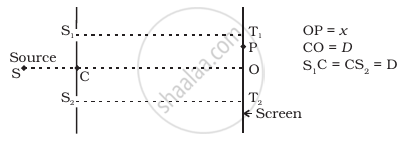Advertisements
Advertisements
प्रश्न
In a Young's double slit interference experiment, the fringe pattern is observed on a screen placed at a distance D from the slits. The slits are separated by a distance d and are illuminated by monochromatic light of wavelength \[\lambda.\] Find the distance from the central point where the intensity falls to (a) half the maximum, (b) one-fourth the maximum.
उत्तर
Given:-
Separation between the two slits = d
Wavelength of the light = \[\lambda\]
Distance of the screen = D
(a) When the intensity is half the maximum:-
Let Imax be the maximum intensity and I be the intensity at the required point at a distance y from the central point.
So,
\[I = a^2 + a^2 + 2 a^2 \cos\phi\]
Here, \[\phi\] is the phase difference in the waves coming from the two slits.
So, \[I = 4 a^2 \cos^2 \left( \frac{\phi}{2} \right)\]
\[\Rightarrow \frac{I}{I_\max} = \frac{1}{2}\]
\[ \Rightarrow \frac{4 a^2 \cos^2 \left( \frac{\phi}{2} \right)}{4 a^2} = \frac{1}{2}\]
\[ \Rightarrow \cos^2 \left( \frac{\phi}{2} \right) = \frac{1}{2}\]
\[ \Rightarrow \cos\left( \frac{\phi}{2} \right) = \frac{1}{\sqrt{2}}\]
\[ \Rightarrow \frac{\phi}{2} = \frac{\pi}{4}\]
\[ \Rightarrow \phi = \frac{\pi}{2}\]
Corrosponding path difference, \[∆ x = \frac{\lambda}{4}\]
\[ \Rightarrow y = \frac{∆ xD}{d} = \frac{\lambda D}{4d}\]
(b) When the intensity is one-fourth of the maximum:-
\[\frac{I}{I_\max} = \frac{1}{4}\]
\[ \Rightarrow 4 a^2 \cos^2 \left( \frac{\phi}{2} \right) = \frac{1}{4}\]
\[ \Rightarrow \cos^2 \left( \frac{\phi}{2} \right) = \frac{1}{4}\]
\[ \Rightarrow \cos\left( \frac{\phi}{2} \right) = \frac{1}{2}\]
\[ \Rightarrow \frac{\phi}{2} = \frac{\pi}{3}\]
So, corrosponding path difference, \[∆ x = \frac{\lambda}{3}\]
and position, \[y = \frac{∆ xD}{d} = \frac{\lambda D}{3d}.\]
APPEARS IN
संबंधित प्रश्न
What is the effect on the fringe width if the distance between the slits is reduced keeping other parameters same?
In a double-slit experiment using the light of wavelength 600 nm, the angular width of the fringe formed on a distant screen is 0.1°. Find the spacing between the two slits.
Using monochromatic light of wavelength λ in Young’s double slit experiment, the eleventh dark fringe is obtained on the screen for a phase difference of ______.
A beam of light consisting of two wavelengths, 650 nm and 520 nm, is used to obtain interference fringes in a Young’s double-slit experiment.
What is the least distance from the central maximum where the bright fringes due to both the wavelengths coincide?
The fringes produced in diffraction pattern are of _______.
(A) equal width with same intensity
(B) unequal width with varying intensity
(C) equal intensity\
(D) equal width with varying intensity
If one of two identical slits producing interference in Young’s experiment is covered with glass, so that the light intensity passing through it is reduced to 50%, find the ratio of the maximum and minimum intensity of the fringe in the interference pattern.
Write three characteristic features to distinguish between the interference fringes in Young's double slit experiment and the diffraction pattern obtained due to a narrow single slit.
A beam of light consisting of two wavelengths, 800 nm and 600 nm is used to obtain the interference fringes in a Young's double slit experiment on a screen placed 1 · 4 m away. If the two slits are separated by 0·28 mm, calculate the least distance from the central bright maximum where the bright fringes of the two wavelengths coincide.
In Young’s double slit experiment to produce interference pattern, obtain the conditions for constructive and destructive interference. Hence deduce the expression for the fringe width.
If the source of light used in a Young's double slit experiment is changed from red to violet, ___________ .
Draw a neat labelled diagram of Young’s Double Slit experiment. Show that `beta = (lambdaD)/d` , where the terms have their usual meanings (either for bright or dark fringe).
How is the fringe width of an interference pattern in Young's double-slit experiment affected if the two slits are brought closer to each other?
In Young's double slit experiment using monochromatic light of wavelength 600 nm, 5th bright fringe is at a distance of 0·48 mm from the centre of the pattern. If the screen is at a distance of 80 cm from the plane of the two slits, calculate:
(i) Distance between the two slits.
(ii) Fringe width, i.e. fringe separation.
In Young’s double-slit experiment, show that:
`beta = (lambda "D")/"d"` where the terms have their usual meaning.
In Young’s double slit experiment, what should be the phase difference between the two overlapping waves to obtain 5th dark band/fringe on the screen?
Young's double slit experiment is made in a liquid. The 10th bright fringe lies in liquid where 6th dark fringe lies in vacuum. The refractive index of the liquid is approximately
In Young's double slit experiment shown in figure S1 and S2 are coherent sources and S is the screen having a hole at a point 1.0 mm away from the central line. White light (400 to 700 nm) is sent through the slits. Which wavelength passing through the hole has strong intensity?

Consider a two-slit interference arrangement (Figure) such that the distance of the screen from the slits is half the distance between the slits. Obtain the value of D in terms of λ such that the first minima on the screen falls at a distance D from the centre O.

In a Young's double slit experiment, the width of the one of the slit is three times the other slit. The amplitude of the light coming from a slit is proportional to the slit- width. Find the ratio of the maximum to the minimum intensity in the interference pattern.
